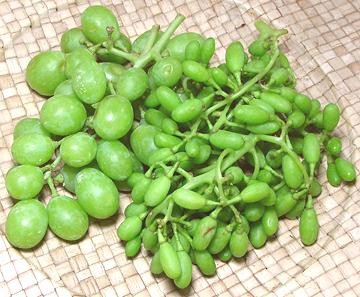 Verjuice is quite sour, but lighter and fruitier than vinegar. Chefs
often use it in place of vinegar in salad dressings where there will be
wine at the same time as salad. It interferes less with the wine than
vinegar would.
Verjuice is quite sour, but lighter and fruitier than vinegar. Chefs
often use it in place of vinegar in salad dressings where there will be
wine at the same time as salad. It interferes less with the wine than
vinegar would.
 [Verjuice, Verjus; Ab-ghooreh (Persia); Husroum (Arabic)]
[Verjuice, Verjus; Ab-ghooreh (Persia); Husroum (Arabic)]
Before vinegar production was perfected, verjuice was a major souring ingredient in Europe. It is most often made from unripe grapes. It is essential for accurately reconstructing Ancient, Medieval and Renaissance cuisines and is still somewhat used in France and parts of the American South. It is also much used in the cuisines of Anatolia, Caucasus, and the Near and Middle East. It is available bottled from California and Perigord, France, and is currently a "gourmet" item in Australia.
In some early English cookbooks verjus means juice of crab apples. Since real crab apples (they are tiny with very long stems, like a big cherry) are now all but impossible to get in North America, we will consider only grapes.
Due to our large communities from Armenia and the Near and Middle East, unripe grapes are widely available in produce markets here in Los Angeles, when in season. The two bunches in the photo show the extremes of size (0.28 to 0.65 inch diameter) - Both were just as sour, but the large ones had a faint hint of sweet. The ideal will be just a touch smaller than the big ones, the tiny ones will produce a less flavorful verjus.
Harvested as part of normal vineyard maintenance, sour grapes are most available from April through June. Verjuice can be made from them and frozen for use the rest of the year. The photo specimens were purchased in early June.
More on Grapes
 Verjuice is quite sour, but lighter and fruitier than vinegar. Chefs
often use it in place of vinegar in salad dressings where there will be
wine at the same time as salad. It interferes less with the wine than
vinegar would.
Verjuice is quite sour, but lighter and fruitier than vinegar. Chefs
often use it in place of vinegar in salad dressings where there will be
wine at the same time as salad. It interferes less with the wine than
vinegar would.
Buying and Storing: Verjuice is now made and bottled by some California vineyards, but I haven't seen it here in Los Angeles - it's probably found in gourmet shops over on the West Side, but I don't shop there. It is available on-line from both California and Perigord, France.
In season it's very easy to find sour grapes, at least here in
Southern California where any produce market serving an Armenian or
Near or Middle Eastern community will have them. Try to get a size
just a shade smaller than the big ones in the photo above. Buy them
when you see them, make your juice and freeze it.
Method:
Yield: The small grapes in the photo yielded 1 cup from 13 ounces of grapes as purchased. The larger grapes yielded 1 cup from 10-1/2 ounces. Not only was the yield better, they were much easier to handle and made a better verjus, so are preferred over the small ones.
gp_verjz 120609 - www.clovegarden.com
©Andrew Grygus - agryg@clovegarden.com - Photos
on this page not otherwise credited © cg1
- Linking to and non-commercial use of this page permitted